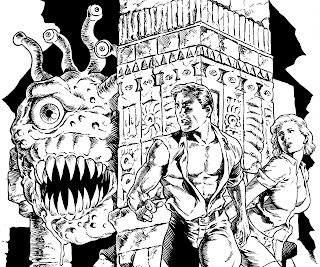The cover to Micronauts # 1 (January 1979) shows the influence of Star Wars as much as the toyline. Particularly note black armored Darth--uh, Baron--Karza menacing the heroes. The similarities don’t end there. There are two droids (Biotron and Microtron), a princess (Marionette), and a hero who taps into an enigmatic, quasi-mystical force (The Enigma Force).
Despite those similarities, Micronauts has a lot of interesting ideas of its own, though the basic set-up is pure space opera: Commander Rann returns from a 1000 year (mostly suspended animation) exploration of molecular-model resembling worlds of the Microverse (a “sub-atomic” universe), to find his old teacher (Karza) has led an insurrection and become dictator of Homeworld. Rann teams up with the overthrown royals, Princess Mari (Marionette of the Farah Fawcett hair), and Acroyear (armored warrior of Spartak), and Bug, insectoid wisecracker.
A simple story, sure, but it's the details that really make it work. Baron Karza’s coup was supported by much of populace because he promised them immortality through the use of his DNA-altering Body Banks, which he also uses to make inhuman soldiers from political enemies. The Acroyear people of Spartak are the obligatory warrior race, and are never seen outside of their cool armor. They've also got slightly oversized mediveal weaponry sorrounded by energy and Kirby dots. Unlike Darth Vader, Karza has a white armor-clad opposite number in the person of Prince Argon.
Micronauts had 57 issues of its original run. That was followed by a crossover limited series with the X-Men. The final series, Micronauts: The New Voyages, had writer Peter Gillis and artist Kelley Jones taking the team out of their familiar haunts and into unexplored regions of the Microverse. It’s a well written series, though strikes a different chord than the space operatic original, and serves to “finish” the Micronauts story.
So fan of the toys or no, those with an interest in, or looking for inspiration for, classic seventies cinematic space opera, ought to give Micronauts a look.






















